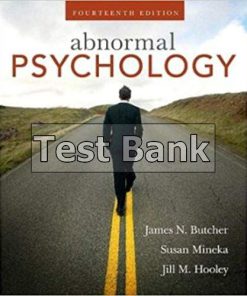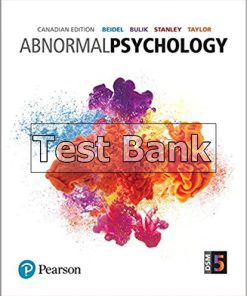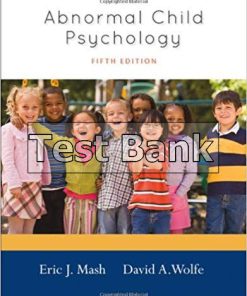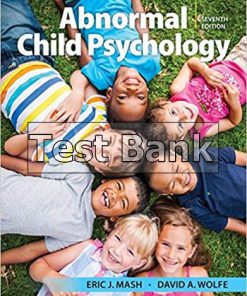Psychology of Language An Integrated Approach 1st Edition Luuden Test Bank
$26.50$50.00 (-47%)
Psychology of Language An Integrated Approach 1st Edition Luuden Test Bank.
You may also like
This is completed downloadable of Psychology of Language An Integrated Approach 1st Edition Luuden Test Bank
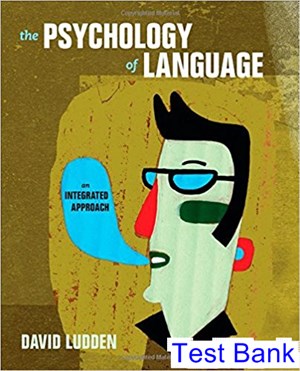
Product Details:
- ISBN-10 : 1452288801
- ISBN-13 : 978-1452288802
- Author: David Ludden
Breaking through the boundaries of traditional psycholinguistics textbooks, The Psychology of Language: An Integrated Approach takes an integrated, cross-cultural approach that weaves the latest developmental and neuroscience research into every chapter. Separate chapters on bilingualism and sign language and integrated coverage of the social aspects of language acquisition and language use provide a breadth of coverage not found in other texts. In addition, rich pedagogy in every chapter and an engaging conversational writing style help students understand the connections between core psycholinguistic material and findings from across the psychological sciences.
Table of Content:
- Chapter 1. Animal Communication and Human Language
- Section 1.1: Animal Communication Systems
- Food
- Foe
- Friend
- Finding a Mate
- General Features of Animal Communication Systems
- In Sum
- • Review Questions
- • Thought Questions
- • Google It! Honeybee Waggle Dance
- Section 1.2: Human Language
- Laugh, and the World Laughs With You
- Speech! Speech!
- Rules, Structure, and Arbitrary Symbols
- Pyramid Scheme
- Sentences and Discourse
- Long, Long Ago, in a Galaxy Far, Far Away…
- In Sum
- • Review Questions
- • Thought Questions
- • Google It! Chimpanzee Laughter
- Section 1.3: Evolution of Language
- Out of Africa
- Hopeful Monster
- A Language Gene?
- Long Time No See
- Hush, Little Baby, Don’t You Cry
- In Sum
- • Review Questions
- • Thought Questions
- • Google It! Pidgins
- Section 1.4: Living Fossils
- Half an Eye
- Me Tarzan, You Jane
- Planet of the Apes
- Baby Talk
- At a Loss for Words
- In Sum
- • Review Questions
- • Thought Questions
- • Google It! Washoe, Koko, and Kanzi
- Chapter 2. The Science of Language
- Section 2.1: Scientific Method
- Just a Theory
- You Can’t Prove It
- From Observation to Explanation
- Constructs
- In Sum
- • Review Questions
- • Thought Questions
- • Google It! Digit Span
- Section 2.2: Experiment Design
- Elements of an Experiment
- The Experimentation Process
- In Sum
- • Review Questions
- • Thought Questions
- • Google It! Mythbusters
- Section 2.3: Behavioral Techniques
- Measured Response
- Bread and Butter
- Building Blocks
- Total Recall
- Learning Without Knowing
- Moving Eyes
- In Sum
- • Review Questions
- • Thought Questions
- • Google It! Eye Tracking
- Section 2.4: Language and the Brain
- What’s Inside Your Head
- “Listening” to the Brain
- “Watching” the Brain in Action
- In Sum
- • Review Questions
- • Thought Questions
- • Google It! Brain Imaging
- Chapter 3. Speech Perception
- Section 3.1: Auditory Perception
- The Look of Sound
- From Sound to Thought
- The World of Sound
- In Sum
- • Review Questions
- • Thought Questions
- • Google It! Sine Wave Speech
- Section 3.2: The Speech Stream
- The Speech Stream
- The Sound of Silence
- Read My Lips
- In Sum
- • Review Questions
- • Thought Questions
- • Google It! The McGurk Effect
- Section 3.3: The Development of Speech Perception
- Language Learning in the Womb
- Born Yesterday
- Baby Talk
- I’ve Got Rhythm
- What’s Coming Next
- Narrowing Down
- Putting the Pieces Together
- In Sum
- • Review Questions
- • Thought Questions
- • Google It! Infant Speech Discrimination
- Section 3.4: Theories of Speech Perception
- Motor Theory
- General Auditory Framework
- Direct Realism
- In Sum
- • Review Questions
- • Thought Questions
- • Google It! Brain in a Vat
- Chapter 4. Speech Production
- Section 4.1: The Vocal Tract and the Production of Speech
- Vocal Tract
- Consonants: Place of Articulation
- Consonants: Manner of Articulation
- Vowels
- In Sum
- • Review Questions
- • Thought Questions
- • Google It! Click Languages
- Section 4.2: Speech Areas of the Brain
- Wernicke-Geschwind Model
- Cerebral Cortex
- Talking Is Like Walking
- In Sum
- • Review Questions
- • Thought Questions
- • Google It! Expressive and Receptive Aphasia
- Section 4.3: Models of Speech Production
- Feedforward and Feedback Control
- Auditory Suppression During Speech
- Dual Stream Model
- DIVA
- In Sum
- • Review Questions
- • Thought Questions
- • Google It! Speech Jammer
- Section 4.4: Development of Speech Production
- Stages of Babbling
- Frames-Then-Content Model
- Social Aspects of Babbling
- Speech Delays and Disorders
- In Sum
- • Review Questions
- • Thought Questions
- • Google It! Babbling Babies
- Chapter 5. Words
- Section 5.1: Anatomy of Words
- Words Are Labels for Concepts
- Types of Words
- Shapeshifters
- Phonology of Word Forms
- Words as Symbols
- Sound Symbolism
- In Sum
- • Review Questions
- • Thought Questions
- • Google It! Bouba Kiki and the Chinese Room
- Section 5.2: How Words Are Learned
- On a Curve
- In the Fast Lane
- Not So Fast
- In the Neighborhood
- In Sum
- • Review Questions
- • Thought Questions
- • Google It! Culturomics
- Section 5.3: How Words Are Stored
- Phonological Forms
- Exploring the Mental Lexicon
- Cortical Organization of the Mental Lexicon
- In Sum
- • Review Questions
- • Thought Questions
- • Google It! Mind Maps
- Section 5.4: How Words Are Retrieved
- Spoken Word Recognition
- Spoken Word Production
- The Levelt Feedforward Model
- The Dell Interactive Model
- In Sum
- • Review Questions
- • Thought Questions
- • Google It! Tip of the Tongue
- Chapter 6. Sentences
- Section 6.1: Sentence Structure
- Mind Meld
- Syntactic Structures
- Adding Complexity
- In Sum
- • Review Questions
- • Thought Questions
- • Google It! Yoda Translator
- Section 6.2: Comprehending Sentences
- Down the Garden Path
- Late Closure
- Minimal Attachment
- Priming
- Anticipation
- Broca’s Area Revisited
- In Sum
- • Review Questions
- • Thought Questions
- • Google It! Elephant in My Pajamas
- Section 6.3: Producing Sentences
- Vertical and Horizontal Flow of Information
- Planning Scope
- Visual Attention and Sentence Production
- Sentence Production and the Brain
- In Sum
- • Review Questions
- • Thought Questions
- • Google It! Sentence Production and Aphasia
- Section 6.4: Learning Syntactic Structure
- Cracking the Code
- The Terrible Twos
- Models of Syntax Acquisition
- Incremental Structure Building
- The Primacy of Meaning
- Language Impairments
- Language Development and the Brain
- In Sum
- • Review Questions
- • Thought Question
- • Google It! Specific Language Impairment
- Chapter 7. Discourse
- Section 7.1: Conversation
- Anatomy of a Conversation
- Turn Construction
- Turn Transition
- Turn-Taking Rules
- In Sum
- • Review Questions
- • Thought Questions
- • Google It! Cell Phone Versus Drunk Driving
- Section 7.2: Narrative and Reference
- Narrative
- Story Grammar
- Reference
- In Sum
- • Review Questions
- • Thought Questions
- • Google It! Teaching Reading With Story Grammar
- Section 7.3: Anaphora and Inference
- Anaphora
- Making Inferences
- Speech Acts
- In Sum
- • Review Questions
- • Thought Questions
- • Google It! Flouting Gricean Maxims
- Section 7.4: Development of Discourse Abilities
- Conversational Turn-Taking
- Late Talkers
- Gesture
- Prosody
- Gricean Maxims
- Discourse Impairments
- In Sum
- • Review Questions
- • Thought Questions
- • Google It! Still Face Experiment
- Chapter 8. Reading and Writing
- Section 8.1: Writing Systems
- Writing Systems of the World
- Shallow Versus Deep Orthography
- The Brain’s Letterbox
- In Sum
- • Review Questions
- • Thought Questions
- • Google It! History of Writing
- Section 8.2: Cognitive Processes in Reading
- Eye Movements
- Models of Lexical Access in Reading
- Text Comprehension
- In Sum
- • Review Questions
- • Thought Questions
- • Google It! Acquired Reading Disorder
- Section 8.3: Development of Reading Skills
- Learning to Read
- Developmental Dyslexia
- Developmental Dyslexia and the Brain
- Early Intervention
- In Sum
- • Review Questions
- • Thought Question
- • Google It! Phonological Awareness
- Section 8.4: Cognitive Processes in Writing
- Learning the ABCs
- Learning to Spell
- Learning to Compose Texts
- The Hayes Model
- Modeling the Development of Writing Skills
- Visuospatial Aspects of the Text
- In Sum
- • Review Questions
- • Thought Questions
- • Google It! The Cursive Controversery
- Chapter 9. Bilingualism
- Section 9.1: The Bilingual Experience
- The Bilingual World
- Languages and Dialects
- Immigration to the United States
- Multigenerational Bilingualism
- Codeswitching
- Language and Identity
- In Sum
- • Review Questions
- • Thought Questions
- • Google It! Codeswitching
- Section 9.2: Organization of The Bilingual Mind
- Two Tongues in One Head
- Links Between the Two Languages
- The Bilingual Disadvantage
- Models of the Bilingual Lexicon
- In Sum
- • Review Questions
- • Thought Questions
- • Google It! Myths About Bilingual Children
- Section 9.3: Cognitive Benefits of Bilingualism
- Executive Control
- The Bilingual Brain
- Cognitive Reserve
- Bilingualism and Language Disorders
- In Sum
- • Review Questions
- • Thought Questions
- • Google It! The Bilingual Advantage
- Section 9.4: Second-Language Acquisition
- Ultimate Attainment
- Critical Period Hypothesis
- Speech Learning Model
- Bilingual Home Environment
- Bilingual Education
- The End Game
- In Sum
- • Review Questions
- • Thought Questions
- • Google It! Foreign Accent Training
- Chapter 10. Signed Language
- Section 10.1: Sign Language Communities
- How Sign Languages Arise
- The Rise of National Sign Languages
- Signed Versus Spoken Languages
- In Sum
- • Review Questions
- • Thought Questions
- • Google It! Signed English
- Section 10.2: Characteristics of Signed Languages
- The Structure of Signs
- Sign Language Prosody
- Language in 3-D
- In Sum
- • Review Questions
- • Thought Questions
- • Google It! Singing in Sign Language
- Section 10.3: Language Acquisition in Deaf Children
- Deaf Children of Deaf Parents
- Deaf Children of Hearing Parents
- Hearing Children of Deaf Parents
- Learning to Speak
- Learning to Read
- In Sum
- • Review Questions
- • Thought Questions
- • Google It! Cochlear Implants and Speechreading
- Section 10.4: Deaf Culture
- Horizontal Transmission
- Medical Model
- Storytelling in Sign Language
- Deaf Humor
- In Sum
- • Review Questions
- • Thought Question
- • Google It! Deaf Blogs
- Chapter 11. Language Development Across the Lifespan
- Section 11.1: Infancy
- Developmental Cascades
- Babytalk
- Learning Words
- Walking and Talking
- Story Time
- In Sum
- • Review Questions
- • Thought Questions
- • Google It! Developmental Milestones
- Section 11.2: The Preschool Years
- Phonology
- Lexicon
- Morphosyntax
- Syntax
- Literacy
- In Sum
- • Review Questions
- • Thought Questions
- • Google It! Fast Mapping
- Section 11.3: The School-Age Years
- Oral Language and Literacy
- Vocabulary Growth
- Producing Discourse
- In Sum
- • Review Questions
- • Thought Questions
- • Google It! Language and Math Skills
- Section 11.4: Adulthood and Aging
- You’re Not Getting Older, You’re Getting Better
- Mostly Downhill, But With Some High Points
- Multitasking
- The Aging Brain
- It’s on the Tip of My Tongue
- Happy Ever After
- In Sum
- • Review Questions
- • Thought Questions
- • Google It! Hearing and Happiness
- Chapter 12. Language, Culture, and Thought
- Section 12.1: Words and Thought
- What Language Do You Think In?
- The Amazing Technicolor World
- Fifty Shades of Grue
- Language and the Perception of Emotion
- In Sum
- • Review Questions
- • Thought Questions
- • Google It! What Colors Can You See?
- Section 12.2: Grammar and Thought
- Is That Apple Male or Female?
- It’s a Piece of Cake
- Too Much Stuff, Too Many Things
- Jumping Jack Rabbit, or Down the Bunny Hole
- In Sum
- • Review Questions
- • Thought Questions
- • Google It! Mark Twain and “The Awful German Language”
- Section 12.3: Figurative Language
- It’s Just a Figure of Speech
- Who Spilled the Beans?
- Isn’t That Ironic?
- Left Brain, Right Brain
- In Sum
- • Review Questions
- • Thought Questions
- • Google It! The Brain’s Default Mode Network
- Section 12.4: Taboo Language
- Emotional Words
- Soap in Your Mouth
- Colorful Language
- Dirty Mind
- Politely Speaking
- In Sum
- • Review Questions
- • Thought Questions
- • Google It! The Seven Dirty Words
- Chapter 13. Language and Technology
- Section 13.1: Cell Phones
- Risky Business
- Blinded by the Phone
- Send in the Clowns
- Need to Listen
- In Sum
- • Review Questions
- • Thought Questions
- • Google It! Did You See the Clown?
- Section 13.2: Texting
- A Brief History of Texting
- Texting Today
- Texting on the Go
- CUL8R
- In Sum
- • Review Questions
- • Thought Questions
- • Google It! The Dvorak Keyboard
- Section 13.3: Natural Language Processing
- When HAL Met Siri . . .
- Listen to Me
- “Press 1 for . . .”
- Q & A
- Giving Voice to the Silenced
- In Sum
- • Review Questions
- • Thought Questions
- • Google It! Remaking a Voice
- Section 13.4: Artificial Intelligence
- Talk to Me
- Passing the Test
- Eyes on the Prize
- Back in the Chinese Room
- Full Body Workout
- Turning the Tables on the Turing Test
- In Sum
- • Review Questions
- • Thought Questions
- • Google It! Chatbots
- Glossary
- References
- Index
People Also Search:
psychology of language an integrated approach luuden
psychology of language an integrated approach 1st edition luuden
psychology of language an integrated approach
psychology of language an integrated approach 1st edition
psychology of language an integrated approach 1st edition download scribd
psychology of language an integrated approach 1st edition testbank download pdf







